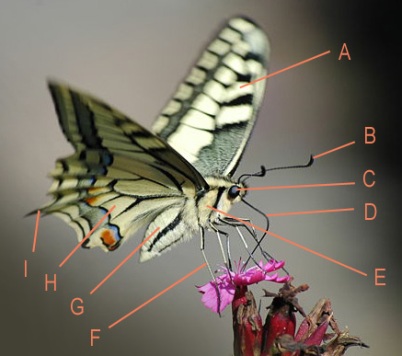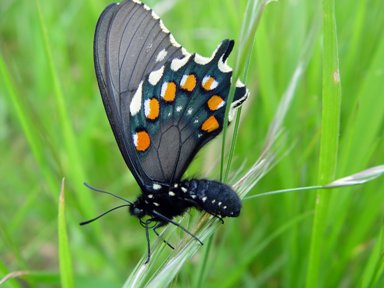Adaptation
"I'll be floating like a butterfly and stinging like a bee."
- Muhammad Ali
The anatomy of the butterfly is similar to some insects but different from others. The most noticeable characteristic of Battus philenor is the wings. The wings are made out of chitin and there are two sets of wings--the forewings and the hindwings (Wilson, 2008). The forewings of the butterfly have a triangular shape and are near the head, while the hindwings are shaped like fans or seashells and are near the tail (Wilson, 2008). The colors and patterns of the butterflies’ wings come from the scales (Wilson, 2008). The scales cover the membrane of the wings by overlapping in the same manner as shingles on a roof (Hadley, Swallowtails). The scales provide strength and stability for the wings and the butterfly cannot regenerate lost scales (Hadley, Swallowtails).
.jpg) Image courtesy of Wikimedia Commons. The image to the left is not
Battus philenor. The picture shows a series of photographs in
increasing magnification showing the scales of a butterfly's wing.
Image courtesy of Wikimedia Commons. The image to the left is not
Battus philenor. The picture shows a series of photographs in
increasing magnification showing the scales of a butterfly's wing.
Some other physical features of a Battus philenor are that they are bilaterally symmetric and heterothermic. (Ramos, 2001) Heterothermic means that the body temperature depends on the environment. Bilaterally symmetric means that they have one line of symmetry. This butterfly functions best when the temperature is around 82°F. The butterfly will not fly if it is too cold. (Wilson, 2008) At night butterflies roost or take cover to protect them from the temperature drop (Wilson, 2008). To keep their body temperature up during the day, Battus philenor can be seen basking. Basking is when the butterfly uses their wings as reflectors to keep their body temperature up. They can also soak up the warmth from rocks that are in the sun to keep their body temperature up (Wilson, 2008). If the butterfly gets too warm, they fold their wings flat so the sun hits the narrow edge of the wings (Wilson, 2008). This prevents the butterfly form overheating.
Battus philenor has an open circulatory system that consists of a "tube heart". The heart is made up of a number of linearly arranged chambers. This allows for a large amount of hemolymph to flow into and out of the surrounding sinus. The "tube heart" allows Battus philenor to move quickly.
Battus philenor has adaptations that have helped it to be a
more successful organism. One adaptation that has made the
butterfly successful, would be the proboscis. The proboscis looks
like a long straw-like tube that is used for feeding (Wilson,
2008). To learn about how Battus philenor gets their nutrition
visit the Nutrition page. Another
structure the butterfly has is compound eyes,
which are for detecting color and nearby movement (Wilson,
2008). Compound eyes see many images of one thing and then the
brain combines them into one.
 This helps the butterfly see
flowers or other organisms. The antennae of the butterfly are for detecting smells
and sensing direction (Wilson, 2008). The Labial palps are at
the base of the butterfly's mouth to help the butterfly decide
what is and isn't food. (Wilson, 2008) There are also
taste organs at the end of the six legs of the butterfly
(Wilson, 2008). These taste organs help the butterfly confirm
that what they have landed on is food. The reproduction organs are in the abdomen of
the butterfly. (Wilson, 2008)
This helps the butterfly see
flowers or other organisms. The antennae of the butterfly are for detecting smells
and sensing direction (Wilson, 2008). The Labial palps are at
the base of the butterfly's mouth to help the butterfly decide
what is and isn't food. (Wilson, 2008) There are also
taste organs at the end of the six legs of the butterfly
(Wilson, 2008). These taste organs help the butterfly confirm
that what they have landed on is food. The reproduction organs are in the abdomen of
the butterfly. (Wilson, 2008)
Image courtesy of Wikimedia Commons. The picture above is of Papilio machaon not Battus philenor. The image shows where the parts of a butterfly are located. A- forewing, B- antennae, C- compound eye, D- proboscis, E- thorax, F- legs, G- abdomen, H- hindwing, I- "tail".
The most important adaption Battus philenor has would
be the defense
mechanism. As larvae, the caterpillars eat the leaves of plants from the
Aristolochiaceae, most commonly the Pipevines (Aristolochia
mocrophylla). These plants contain
compounds called aristolochic acids that the caterpillars incorporate
into their bodies (Schappert, 2000). These compounds make the larvae
distasteful and deadly to predators (Mikula, 1997). Battus philenor eggs
are not poisonous at first. The larvae have to eat the plant in order to
become poisonous to gain the aristolochic acids from the plant. This
poison carries on into the adult form.
Image courtesy of Wikimedia Commons. The picture to the right shows the Pipevine plant (Aristolochia mocrophylla) which is a common host plant for Battus philenor larvae.
In a study done by Fordyce, J. et. al., they examined the Battus philenor effect of diapause on the chemical defenses, stored energy reserves and and adult mass. Diapause is a state of dormancy to avoid to temporally avoid unfavorable conditions. The results of that study showed that individuals who developed right away had a higher fat content. The individuals who displayed diapause had a higher content of chemical defense of larvae but they had lower energy reserves (Fordyce, 2006).
Another adaption Battus philenor has would be that the larvae have an osmeterium. An osmeterium is a brightly colored “Y” shaped structure that is located behind the head of the larva that emits an odor. If a predator threatens the larva, it will respond by everting the osmeterium and angling it towards the predator to make sure it gets a good smell of the scent released (Schappert, 2000). There are also glands on the abdomen of the stomach that emit odors when squeezed (Mikula, 1997).
Image courtesy to Wikimedia.
The picture above is not a Pipevine Swallowtail but instead a Black
Swallowtail. This picture shows the osmeterium of the caterpillar. The
Pipevine Swallowtail osmeterium will be brightly colored reddish orange.
Since Battus philenor is brightly colored, it warns predators that it is poisonous. Because of this, many butterflies also copy the morphology of Battus philenor so that predators mistake it for being poisonous (fcps.edu). Some butterflies that mimic Battus philenor includes the Eastern Black Swallowtail (Papilio polyxenes) and Spice Bush Swallowtail (Papilio troilus)(fcps.edu).
.jpg)
.jpg)
Both pictures above were provided from Wikimedia Commons.
The pictures above are not of the Battus philenor but instead
the Eastern Black Swallowtail (left) and Spicebush Swallowtail (right).
As you can see the Eastern Black Swallowtail and Spicebush Swallowtail
look very similar to Battus philenor, which is a benefit to
them to keep predators away.
To continue learning about the Battus philenor see Nutrition.
.jpg)
.jpg)
